#tube worms
Text
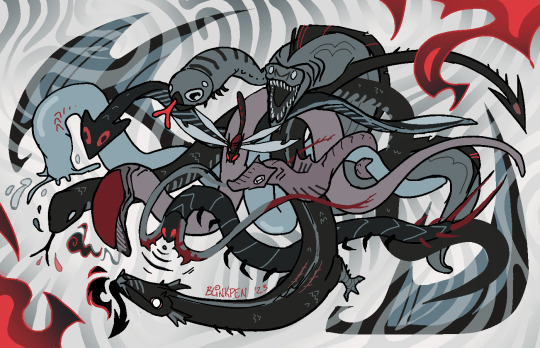
oh, worm??
#mog art#artists on tumblr#dragon#worm#seahorse#wyrm#serpent#snake#caterpillar#centipede#eel#hagfish#flatworm#tube worms#heartworm#dragonfly#one of them On Whim doodles i'll have to make a nice fancy version of later n see what else i can squeeze in#was listening to wriggle by clipping on loop
554 notes
·
View notes
Text

250 notes
·
View notes
Text
Like, I know tube worms are worms. I know that. But.

I think actually they're Ahh! Real Monsters more than anything else, you know?

Giant tube worms are an iconic resident of hydrothermal vents. Hydrothermal vents are extremely cool, because they're one of the uncommon ecosystems that can survive independently from the sun!
Sure, lots of ecosystems live in the dark, but a lot of the food in those ecosystems, at their base, come from sunlight. Something at the surface consumes sunlight, makes energy, then dies and falls or gets eaten by something that swims downward, etc.
These giant tube worms are full of bacteria that are able to eat the chemicals that seep out from the nutrient-rich plumes created by the geology of hydrothermal vents. Basically, the seafloor has cracks, water falls into those cracks, the water gets super hot from the magma below, picks up minerals, then spews out in these different kinds of "plumes". Some are full of iron oxide and come out super dark (Black Smokers), whereas others, full of barium, calcium, and silicon are white (you guessed it, White Smokers). The tube worms live in communities with other deep sea weirdos like Yeti Crabs, clams, and many more.
Hydrothermal vents aren't the only places in the ocean where bacteria (sometimes paired with animals, sometimes on their own) make energy straight from chemicals, but they're probably the most iconic!
#Deep Sea#biology#Animal facts#Tube worms#Have you ever really looked at your worm man#Chemosynthesis
449 notes
·
View notes
Text
Wet Beast Wednesday: giant tube worms
You voted that I would talk about a worm and so I shall discuss the mighty giant tube worms. But first, we need to define what a tube worm is. This is another "no such thing as a fish" situation because there are actually a lot of different things we call tube worms. Turns out the "noodle in a tube" body plan is a pretty successful one. The worms I'm discussing today are members of Siboglinidae, a family of annelids (segmented worms) that was formerly classified as two different phyla until genetic evidence came in. I will primarily be talking about two species: Riftia pachyptila and Lamellibrachia luymesi, who have both adapted to distinct extreme environments in similar ways.

(Image ID: multiple patches of Riftia pachyptila growing from rock at a deep-sea hydrothermal vent. The worms are housed in long, white tubes, some stained yellow. Emerging from the tubes are respiratory organs covered in what appears to be red fur. End ID)
All members of Siboglinidae share a basic body plan consisting of a worm body inside of a mineral tube (side not, I think I will be including an orc or ogre named Sibog in my D&D campaign). The tube is composed of chitin and minerals and is secreted through glands along the body of the worm as it grows from larva to adult. The tube provides the worm within with protection from predators and environmental hazards while also providing support, allowing the worm to lift itself up into the water rather than remain on the substrate. The tube either connects to a solid object or is rooted in the sediment with extensions called roots. The roots are composed of the same material as the tube and can be considerably longer than the rest of the worm, though they are so fragile it is hard to study them. Since the worms often live in large congregations, their roots can twist together is massive mats called ropes. The inside of the tube is where you get into the squishy worm parts. The body of the worm is divided into four regions. The first of these regions I found many alternate names for while researching including cephalic lobe and branchial plume. I'm going to simplify and call it the plume because this segment is composed of one to 200 tentacles that are covered with feathery filaments that can make it look like the plume of a quill pen. The feathery portions of the plume are usually red because they are highly vascularized and filled with blood, similar to a fish's gils. The plume is used for respiration, taking in dissolved oxygen and (depending on the species) other dissolved gasses from the water. In most species, the plume is the only part of the body that extends from the tube. When in the presence of threats, the plume can withdraw into the tube, which can then be close with a structure called the obtraculum, similarly to the operculum found in many other invertebrates like snails. The second body region is the vestimentum. It has a winged shape and is composed of multiple bands of muscle. The vestimentum also contains the heart, a simple brain, and genital pores that release gametes. The third body region, which makes up most of the body, is the trunk. The trunk is the wormiest part of the worm and contains the gonads, the coelom (main body cavity), and the trophosome, which I will come back to later. The last body region is the opistosome, which connects the animal to the tube and is used to store and (maybe) excrete waste.
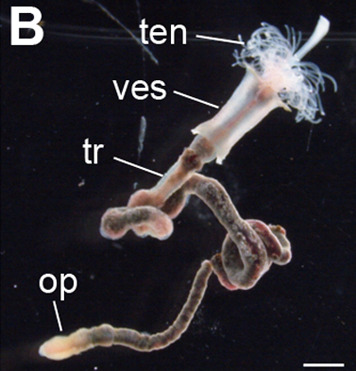
(Image ID: the tubeworm Lamellicrachia satsuma removed from its tube to show its anatomy. It has a plume made up of multiple feathery white tentacles, the vestimentum is a thick white section with flared tips, the trunk is long, brown, and wormlike, and ends with the yellowish opistosome. The body regions are labeled as "op" for opistosome, "tr" for trunk, "ves" for vestimentum, and "ten" for the plume. End ID. Source)
You'll notice that I didn't mention a digestive tract above. That's because these worms don't have one. Instead of a digestive tract, they have a trophosome, an organ composed of highly spongy tissue vascularized by two main blood vessels. Housed within the trophosome is a colony of bacteria that exists in a mutualistic symbiotic relationship with the worm. The worm provides the bacteria with a place to live and protection from predators while the bacteria provide the worm with all of its nutrition. The bacteria are all chemoautotrophs, gaining all their nutrition from chemical reactions using chemicals in their environment without needing to intake nutrients. In particular, they use oxygen, carbon dioxide, and hydrogen sulfide provided to them by the worm. The worm also provides other elements including nitrogen and phosphorus that the bacteria need. I'm going to be honest with you, I tried to comprehend the chemical reactions involved but it's been a long time since I took chemistry and I was never that good anyway so it's over my head. The short version is that the bacteria produces nutrients and chemicals (primarily carbohydrates and ATP) that it shares with the worm. Waste products are also sent into the worm's bloodstream and are sequestered at the opistosome.
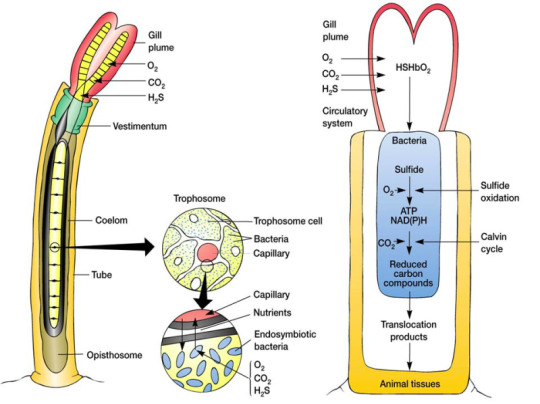
(Image ID: a scientific diagram of the internal anatomy of Riftia pachyptila. Of note is the section showing the trophosome, illustrating it as several yellow, spongy cells filled with bacteria and fed by a capillary. End ID. Source)
The most famous of the tube worms is Riftia pachyptila, which you will recognize if you have ever seen a documentary about the deep sea. They're the ones that look like giant tubes of lipstick. These are the most studied of the Siboglinids and live around hydrothermal vents in the deep pacific ocean. Hydrothermal vents are places on the seafloor where water underground is heated by geothermal activity in the Earth's mantle and then released into the water column, often carrying with it chemicals from deeper in the planet. These vents are hotspots of biodiversity in the deep sea and are hypothesized to play a major role in the origin of life. These ecosystems are among the only ones on the planet where the primary source of energy is not sunlight via photosynthesizing organisms. Instead, chemosynthetic bacteria forms the base of the trophic web, generating energy from the heat and chemicals released by the vents. Riftia requires vents which release sulfur into the water and blanket vents with the right conditions all throughout the Pacific. The lifestyle clearly works for them as they have the fastest grown rate of any marine animal. They can go from a larva to a sexually mature adult of 1.5 meters (4.9 ft) long in 2 years. These worms can reach 3 meters in length (9.75 ft) long, but only get to about 4 cm (1.5 in) in diameter within the tube. When reproducing, males will release blobs of stuck-together sperm called spermatozeugmata that collectively swim towards female worms, entering the tube and seeking out the female's oviduct. The female then releases fertilized larvae into the water. These larvae usually spend a few days in the water column before settling down on the substrate and beginning growth into an adult. However, the larvae have been known to reach newly-formed hot vents up to 200 kilometers away from their parent's vents. We don't know how the larvae find new sites to colonize or how long they can remain in the initial, motile state before succumbing to starvation as the larvae do not have digestive tracts and do not develop their internal bacterial colony until they settle down on the substrate. Once the larva does settle down, it develops its internal colony by intaking bacteria from the water using the plume. Riftia are some of the first organisms to colonize a new vent and play a major role in building that vent's ecosystem. Genetic tests show low genetic diversity amongst and between all colonies, which may be a result of how fast they colonize new vents and the fact that if a vent goes dormant or dies, all of the local worms will die with it.

(Image ID: a cluster of Rifita tubeworms, most of whom have their red, feathery plumes exposed. Some tubes do not have exposed plumes, indicating that either the worm has retracted into the tube or the worm has died. Several crabs are crawling on the tubes. End ID)
The other giant tube worm species I'm spotlighting is Lamellibrachia luymesi. These aren't as flamboyant as Riftia, but can get nearly as large (up to 3 meters) and also play a very important role in their ecosystems, though they are less studied. While Riftia likes it hot, Lamellibrachia is more chill. They live at cold seeps, places in the ocean where hydrogen sulfide and hydrocarbons like methane and oil seep out of the sea floor. Like Riftia, these worms depend entirely on an internal bacterial colony for their nutrition. Oxygen is intaken through the plume, but these worms can't get hydrogen sulfide the same way due to the different conditions. Instead, they absorb the sulfide through their roots. While the hot and cold worms absorb their hydrogen sulfide differently, they both have an adaptation to deal with it: specialized hemoglobin. Most forms of hemoglobin can't carry oxygen in the presence of hydrogen sulfide, which is a problem because that's the whole point of hemoglobin. The tube worms, who need to transport hydrogen sulfide, have specialized hemoglobin that seems to use zinc ions to allow for oxygen to bind to it anyway. The cold seep tube worms also excrete their waste products through the roots, returning it to the sediment. The intake of hydrogen sulfide and sequestering of the wast product in the roots and sediment lets the tube worms play an important role in the cold seep ecosystem. Them intaking the sulfide protects organisms who can't handle it as well and sequestering waste products also keeps it away from organisms who could be harmed by the chemicals in it. Hot vents are inherently unstable places. They are formed primarily in places where two tectonic plates are moving away from each other, exposing the planet's mantle. This exposed spot will eventually cool down and the hot vent will die off. Because of this, hot vent ecosystems grow fast and die young. Cold seeps by contrast are extremely stable and long-lasting. Lamellibrachia luymesi grow very slowly and can live for over 250 years. There's no need to hurry when your food comes out of the ground and won't be going anywhere for a very, very long time.

(Image ID: a colony of Lamellibrachia luymesi. Their tubes are more visibly segmented than those of Rifita, with the top of each segment being noticably wider than the base of the next. The tubes are a pale blue, but switch to white at 2 - 9 segments below the top. Many tubes have brown algae growing on them. The exposed plumes are short, red, and feathery. End ID)
#wet beast wednesday#tube worms#giant tube worms#Lamellibrachia luymesi#Riftia pachyptila#worm#wormblr#hydrothermal vents#cold seeps#marine biology#marine life#annelids#chemosynthesis#zoology#ecology#biology#long post#image described
106 notes
·
View notes
Text

The Common Objects of the Seashore. Written by John George Wood. 1857.
Internet Archive
271 notes
·
View notes
Text
Volcanoes of the Deep Sea (2003)
Watching the film that got me excited about tube worms and the deep ocean when I was just a small child, lost at the Pacific Science Center. Somehow I ended up in a showing of the film all on my own, absolutely riveted by the deep ocean life and geology, until security found me and brought me back to my parents.
I don't remember if I was there from the start of the film, but a few minutes in they have some beautiful shots of lobate ctenophores, and I wonder if that day might have been the first time I ever saw a ctenophore.
I've included a link to where the movie is free to watch, in case anyone is interested.
#currently watching#movies#Volcanoes of the deep sea#childhood#deep sea#tube worms#marine biology#ocean#documentary#alvin#deep ocean#free to watch
29 notes
·
View notes
Photo








G.I. JOE: A REAL AMERICAN HERO - “The M.A.S.S. Device, Part 3 - The Worms of Death”
#g.i. joe#gijoeedit#cartoonedit#animationedit#80sedit#tvedit#my gifs#gijoe#gi joe#the mass device#the worms of death#animation#1980s#snake eyes#timber#tube worms#major bludd#the baroness#tv gifs#television
104 notes
·
View notes
Text
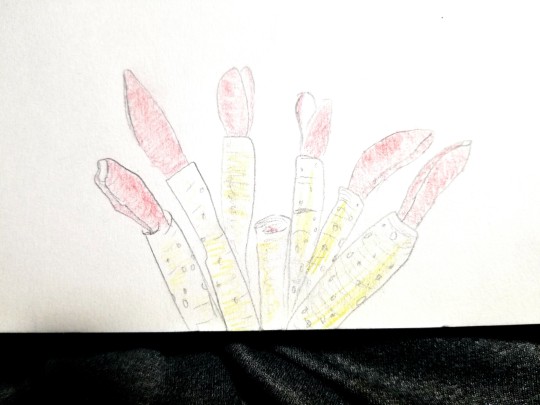
Fishuary Day 11: They're Molluscs?!?!?!
I think they still count as deep sea fish.
@fish-daily
#art#drawing#line art#ink#my art#traditional art#sketch#fish#fishuary2024#@fish daily#tube worms#deep sea fish#day 11#giant tube worm#giant tube worms#giant beard worm#mollusc#molluscs
11 notes
·
View notes
Text
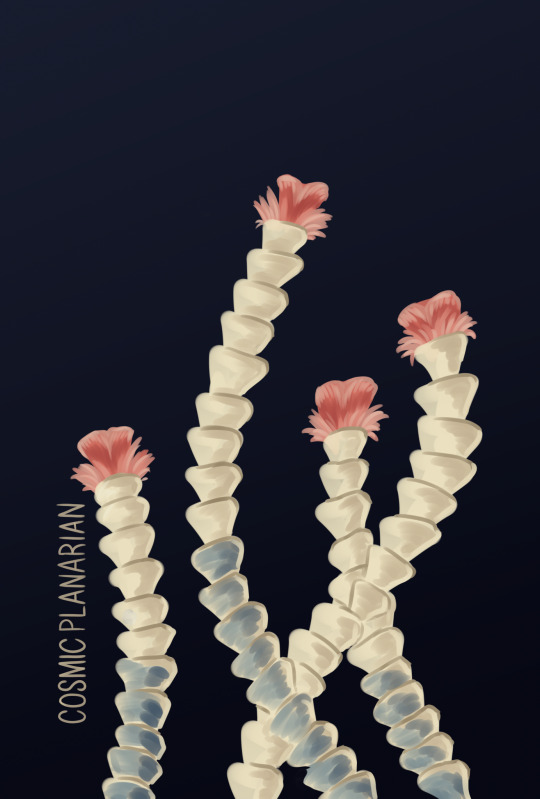
100 Days of Sea Creatures Day 59 - Cold Seep Tube Worm (Lamellibrachia luymesi)
#artists on tumblr#artists on instagram#drawing challenge#sea creature art#drawing daily#deep sea creatures#sea creatures#tube worms#marine invertebrates
11 notes
·
View notes
Text

Tube worms
(found in hydrothermal vent environments)
#tube worms#hydrothermal vents#marine science#marine biology#marine invertebrates#deep sea exploration
16 notes
·
View notes
Photo
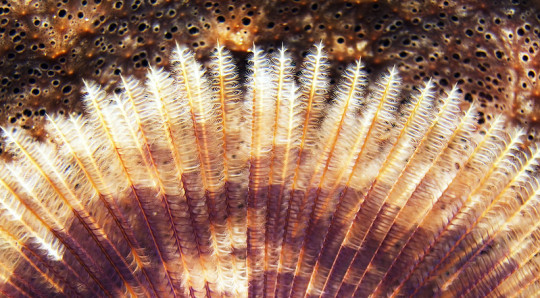
Detail of a feather duster worm (Family Sabellidae) in Grenada
by Sven Roden
#feather duster worm#tube worms#annelid worms#sabellidae#sabellida#annelida#wildlife: grenada#wildlife: caribbean islands
32 notes
·
View notes
Text

filter
278 notes
·
View notes
Text

This is Deep Rising 10 from 2009.
The dragons in this series keep getting more complex. I tried out a bunch of different things here in terms of composition and pattern. These things were fun to draw and color, but I think the overall shape got away from me. It's hard to read the dragon in the design, hard to differentiate body shapes from each other.
All I can do in a case like this is say that I enjoyed the process and will learn from what did and didn't work. I like the patterns a lot, but the contrasts need to be toned down if I want the body to be readable. I will want to give more thought to the way I layer the body so that the pattern works in its favor rather than confuses it. It's okay that it didn't work out as well as I might have wanted, and I'll try using this pattern again someday in a way that makes more sense.
Also, spiral tube worms are a PITA to draw and color. But in the best way.
Prismacolor pencil over a watercolor wash.
#dragon#sea dragon#experimental#not entirely successful but still fun#creative process#tube worms#marine dragon#ocean dragon#too much pattern#traditional art#fantasy art#traditional media#prismacolor
11 notes
·
View notes
Note
if someone scrills and noone is there to witness it, did it really happen?
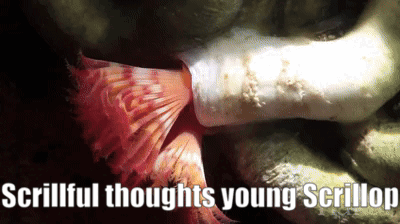
4 notes
·
View notes
Text
I hope it goes without saying that ecosystems surrounding deep sea hydrothermal vents are yuri. I hope you all understand, by now, that chemosynthetic systems- complex webs of life that thrive with neither the heat nor light form the sun, flowers that bloom where no plants can grow, are the yuriest of us all.
12 notes
·
View notes
Text


The Sea and its Wonders. Written by Mary and Elizabeth Kirby. 1871.
Internet Archive
170 notes
·
View notes